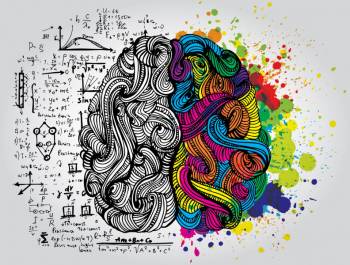Why do we create? It seems inexplicable and mysterious, as if a sudden and unexpected force from above or below has seized us, and will not be denied. Jung, the master of anthropomorphism in psychology, descriptively named this quality the “autonomous complex,” in reference to the compulsive quality of creative expression. An example will help us find the fact beneath the appearance.
I was feeling much better, and indeed, the entire of the day seemed to call me to release and happiness, so I started out early as the sun, hiking some 15 miles before lunch. After my meal, it was clear, the despondency which had gripped me for the last few months had been well and rightly understood, the host of memories once sealed out of sight were recovered, and my mind now reveled easily in the midst of many thoughts which were once too painful to articulate. How splendid is the day we have unfettered from guilt and ignorance of ourselves! Each splash of light was as an invitation to life, and I looked upon the room, just the same as before, but different, now glowing in every happy promise, and I wondered what had changed. The idea was utterly irresistible. I had to know! The room was the same, but not the same, and it seemed as if in a sudden moment of transformation, I understood it all: experience, perception, is an objective substrate of neutral affective valence, endowed entirely and completely with its experiential quality as a function of the affect we assign to it. Perceptual quality is a function of affective assignment: of symbolism. Experience gains its meaning, its quality, not as a function of our source impressions, but instead, as a function of how those impressions are affectively encoded and interpreted. The implications were at once obvious––if all of our human pain and misery can be redefined, reassigned affect to alter its valence, to redistribute our prolific energies once bound into painful fixated ideations anew, then, we might ask the impossible and ultimately hopeful question: Who is lucky now? I had found it, an irresistible notion I needed and wanted to pursue, and indeed, I could imagine a situation where one might feel as I felt at that moment, and no matter what misfortune gripped one, it would not matter, in fact, one would be grateful for it, grateful for whatever Life might bestow… all is right, all is naught, all is perfect, but for this! Every pain in my life seemed to unfold and uncoil, to release its precious energies into the present, and I had found it, found the irresistible answer, the way to end human suffering, and wanted, needed and required, only one thing: To speak its name aloud! I had found––a novel idea. A psychological proof and a bit of analysis will make clear exactly what that is.
First I will remind you of a long established parallel first noted, to my knowledge, by Freud (1900) which states: Dreams are the prototype of psychopathological structures. This intuitively obvious idea has never lost its explanatory force, and has been rightly adopted by the best in the modern field of cognitive neuroscience, where the corresponding neuroanatomy and neurochemistry have been articulated. In REM dreams, we act in bizarre ways most associative and illogical where comparatively unfettered by emotional restraint, we freely hallucinate each night. The reduction in repression allows us to interpret dreams and more easily discover the affect behind their construction, which has been so poorly concealed. In the language of depth psychology: dreams reveal concealed affect as a metapsychological function of the expression of a repressed wish (Freud, 1900), and analogously in the language of cognitive neuroscience, through the encoding of the affective component of experience into a REM dream indicative of neural processing (plasticity), and consolidation into the overall mnemic system, a process which also involves NREM/slow-wave-sleep (Stickgold, et al., 2001; Hobson & Pace-Schott, 2002). Please note also, that the dynamic relation and intra-systemic balance and proportion of activity across neural structures associated with schizophrenic psychosis is mirrored in REM dreaming, which through aminergical demodulation of the mental apparatus, hypo-activates those neural structures such as the dorsolateral prefrontal cortex, that function to support logical processes and more importantly, act as inhibitors of unrestrained affect, while hyper-activating our emotional mainspring, the limbic system (Hobson, 2001; Hobson & Pace-Schott 2002; Pace-Schott, 2003). In my language: REM dreaming provides a snapshot of “the system of affective assignment” operating in unrestrained isolation.
Here is a psychological proof allowing us to further understand the purpose of the creative process:
- Freud idea: Symptoms of neurosis appear as the repressed returns to consciousness. Symptom formation is a product of the return of the repressed.
- Freud idea: A dream is to be analyzed in the same way as a neurotic symptom.
- My idea: Increased proximity to the repressed fosters creativity. Creativity is an expression of the wish to be reunified with the repressed.
- My idea: An artwork can be a “lucid dream” used to heal and unearth repressed material.
- My observation and by my judgment clearly implied if not stated exactly as such in the Freud: Many symptoms serve to maintain repressions by symbolizing the unconscious content and keeping it repressed as only the symbol is given conscious attention. Put briefly: Neurosis keeps personality static by using symptoms to maintain repressions.
- As is evident in propositions one and three, creative endeavor and symptom formation are both fostered by the return of the repressed, ergo: An art work is a substitute symptom. The advantage of our substitute symptom over the neurotic alternative is that when properly constructed, it can heal neurosis by encouraging the reintegration of repressed symptom producing unconscious elements, rather than aiding in their repression and continuing the disease as the original neurotic symptom would have.
Now it is clear what gives the compulsive force to artistic endeavor, it is the exact same mechanism which gives a neurotic symptom its compulsive irresistible character: the return of repressed unconscious contents. However, our substitute symptom, artistic endeavor, may, if properly attended and constructed, become “self-aware” and unearth the very elements which cause psychopathology (Norman, 2011). Ah…it is true!––health and happiness from our pain! The idea took me over its knee and held me fast until the book was finished, and my novel idea, at last, became a real novel, my hope for human kind spelled out in song and story: Enough, the Book of James. All ideas can be articulated as emotional representations and/or intellectual representations, so I will conclude by first stating in my language of ontological calculus (ask for further details if you are interested):
(-I · R= I) = (+Δsu) + (-(Δ?))
This equation states that when the repressed returns and is integrated into the conscious ego, all sublimation, such as creativity, is increased, as well as stability of personality. This is the equation for mental health via our substitute symptom, the equation for “creative psychology.”

Or, from the pages of Enough:
Long forgone are those dreams which know us best, and in tender rapture do bestow their kiss, to warm us from within. How blessed are those dreams which surrender the most precious treasure––How blessed are those dreams which bestow the fact––How blessed are those dreams which create, which dream… of us?
References:
Freud, S. (1900). The standard edition of the complete
psychological works of Sigmund Freud volumes
four and five: The Interpretation of Dreams.
London: Hogarth Press.
Hobson, J. A. (2001). The dream drugstore.
Cambridge, Massachusetts: MIT Press.
Hobson, J. A., & Pace-Schott, E. F. (2002).
The cognitive neuroscience
of sleep: Neuronal systems, consciousness and learning.
Nature Reviews Neuroscience, (3).
doi:10.1038/nrn915
Norman, R. (2011). The tangible self. O’Brien, OR.:
Standing Dead Publications.
Pace-Schott, E. F. (2003). Sleep and dreaming: Scientific
advances and reconsiderations.
Cambridge, UK.: Cambridge University Press.
Stickgold, R., Hobson, J., Fosse, R., Fosse M. (2001).
Sleep, learning, and dreams: Off-line memory reprocessing.
Science, 294, 1052 – 1057. doi: 10.1126/science.1063530




